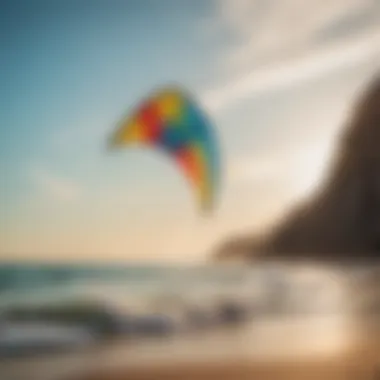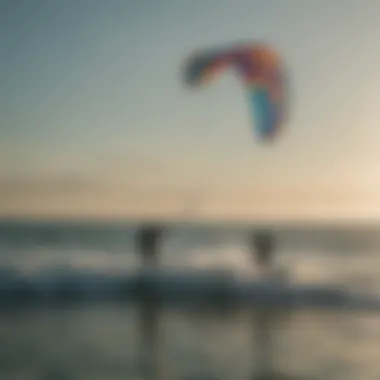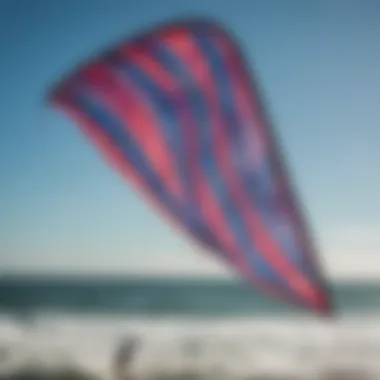Exploring Flexifoil Kitesurfing: A Detailed Overview


Intro
In the dynamic world of kiteboarding, Flexifoil stands out as a vanguard of innovation and performance. Originating from humble beginnings, the brand has carved a niche for itself, becoming synonymous with quality and adventure on the water. Not only do their kites enhance the riding experience, but they have also paved the way for new techniques and explorations in the sport. This article aims to give a thorough examination of Flexifoil kitesurfing—its evolution, the diverse models available, their performance specs, and how these factors intertwine to influence kiteboarding as we know it today.
Gear Insights
When it comes to kitesurfing, selecting the right gear is crucial. Navigating the myriad of options out there can feel like looking for a needle in a haystack. Here, we will dive into the latest gear reviews and essential recommendations for newcomers, ensuring that every rider finds the right fit for their style and skill level.
Latest Gear Reviews
Flexifoil continues to advance their kite technology, making strides that appeal to both seasoned riders and those just getting their feet wet. Recent models like the Flexifoil Blade and the Flexifoil Void have received accolades for their design and performance.
- Flexifoil Blade: Known for its powerful pull and stable performance, the Blade is ideal for aggressive riders seeking to harness the wind’s might for tricks or speed.
- Flexifoil Void: This model is praised for its versatility, being adept in diverse wind conditions. Its responsive handling makes it a favorite among freeriders.
Users on forums like reddit.com have noted the enhanced control and easy relaunch capabilities of these models, allowing for a smoother experience, especially for less experienced kiteboarders.
Essential Gear for Beginners
Jumping into kitesurfing can feel a tad daunting, but having the right gear makes all the difference. For newbies, the following essentials are a must:
- Kite Size: It's recommended to start with a mid-range kite, depending on your weight and local wind conditions.
- Harness: A comfortable and supportive harness is crucial as it distributes the kite's pull evenly, reducing fatigue.
- Board: Choose a board that's forgiving for learning. A larger, more buoyant board helps in stability while you practice.
- Safety Gear: A helmet and impact vest can prevent injuries as you master the elements.
"Selecting the right equipment isn’t just about performance; it’s about ensuring your safety and having an enjoyable experience."
Techniques and Tips
Building skill in kitesurfing goes hand-in-hand with understanding the nuances of the sport. This section explores advanced tricks along with fundamental safety practices.
Advanced Tricks and Techniques
For those looking to up their game, mastering tricks like the Backroll or the Kite Loop can add flair to your riding. Practicing in controlled settings is crucial. Make sure to:
- Begin with small jumps to gauge your comfort level.
- Work on body positioning and timing—focus on smooth landings.
- Don’t forget to capture your attempts; reviewing footage can help refine your technique.
Safety Practices for Kiteboarders
Safety should never take a backseat in this exhilarating sport. Remember these vital rules:
- Always ride with a partner if possible; this ensures someone is there in case of emergencies.
- Familiarize yourself with the local spot’s wind and wave conditions before hitting the water.
- Carry a quick release in case of emergencies, allowing you to detach from the kite swiftly if needed.
As you embark on your kitesurfing adventure with Flexifoil, remember that knowledge, preparation, and the right gear lay a strong foundation for a fulfilling and thrilling experience on the waves.
Preamble to Flexifoil Kitesurfing
The world of kitesurfing is as exhilarating as it is complex, and at the heart of this thrilling sport lies Flexifoil. Understanding the nuances of Flexifoil kitesurfing is crucial because it encapsulates both the evolution of kite technology and the experiences of countless riders. With roots stemming from the early days of kitesurfing, Flexifoil represents a blend of innovation and tradition that appeals to both newcomers and seasoned professionals alike.
Flexifoil hasn’t just created kites; they’ve built a community and fostered a culture around kitesurfing that emphasizes safety, performance, and enjoyment. Their kites are not merely tools; they symbolize the liberation and adventure that characterize the entire sport. The essence of kitesurfing is about harnessing wind power to ride waves, and knowing what differentiates Flexifoil can significantly impact one’s choice and experience on the water.
Understanding the Basics of Kitesurfing
To truly appreciate what Flexifoil brings to the table, one must first grasp the foundational concepts of kitesurfing itself. At its core, kitesurfing involves using a specially designed kite to pull you across the water while you ride on a board. It’s a sport that combines elements of surfing, windsurfing, and paragliding.
Key components of kitesurfing include:
- Kite: This is the heart of the operation; its size and shape can vary greatly and is selected based on wind conditions and rider skill level.
- Board: Riders use several types of boards, from directional boards that resemble surfboards to twin-tips that allow for versatile riding.
- Harness: This connects the rider to the kite’s lines, often worn around the waist to distribute sail pull evenly.
Understanding these basics helps in recognizing the features of Flexifoil kites that enhance performance and overall riding experience. A better grasp of kitesurfing will enable riders to maximize enjoyment and safety.
What Makes Flexifoil Unique?
The uniqueness of Flexifoil lies in its rich history and continual commitment to innovation. Founded in the 1970s, the brand has evolved alongside the sport, consistently refining its designs to meet the dynamic needs of riders.
Several aspects set Flexifoil apart:
- Design Innovation: Their kites are known for aerodynamic efficiency and stability. Riders often note that they feel a distinct control even in challenging conditions.
- Durability: Made from high-quality materials, Flexifoil kites are resilient against wear and tear, making them ideal for both casual users and professionals who demand more from their equipment.
- Variety of Models: From beginner-friendly options to advanced high-performance kites, Flexifoil covers a broad spectrum of rider needs, ensuring everyone can find a kite that suits their style.
By understanding these unique attributes, riders can better appreciate why a Flexifoil kite is not merely an investment in equipment but a gateway to thrilling experiences on water.
Historical Background of Flexifoil
When delving into the world of Flexifoil kitesurfing, understanding its historical background becomes essential. This segment not only highlights the evolution of the brand but also serves as a window into how kitesurfing has morphoed over the years. Brands often hold stories that encompass their journey—challenges faced, innovations introduced, and their influence on the sport. Flexifoil is no exception; its story plays a crucial role in understanding its current standing and reputation in kitesurfing.
Origins of the Brand
Flexifoil’s origins trace back to the late 1970s, marking a pivotal moment in kiting history. Founded in the UK, Flexifoil started as a company focusing on producing power kites for land-based sports. As the winds of change blew, so did the company’s vision. By the mid-1980s, with a shift in focus toward water sports, it became one of the first brands to design kites specifically for kitesurfing—a game changer, to say the least. The initial models were basic, featuring simple shapes and materials, but they laid the groundwork for future advancements.
It’s fascinating to recognize how Flexifoil embraced the evolving landscape of extreme sports. In its infancy, the brand was merely a response to the burgeoning interest in kites as a recreational outlet. However, it rapidly transformed into an innovator within the industry. Through the trial and error of early designs, Flexifoil honed its craft, eventually leading to the development of advanced kites that catered to a diverse range of riders.


Evolution of Kitesurfing Equipment
As kitesurfing gained traction in the late 1990s and early 2000s, Flexifoil continued to evolve its product lineup. The introduction of the Flexifoil Blade was a turning point. This kite was recognized for its unique shape, which allowed enhanced lift and more control. Riders suddenly found themselves doing maneuvers that were previously thought impossible. The responsiveness of the Blade became a worthy feature that elevated riders’ experiences, whether they were just starting or were seasoned pros.
As technology progressed, so did the materials used in kite manufacturing. The transition from traditional fabrics to more lightweight and durable materials marked a significant advancement. Flexifoil, always staying ahead of the curve, quickly adopted these improvements, ensuring its kites were not only robust but also efficient. This evolution wasn’t just about performance; it was about safety and sustainability in kiteboarding.
Furthermore, the integration of digital advancements resulted in better design processes. Kites became more aerodynamic, with precisely calculated wind profiles allowing for excellent control, stability, and overall performance.
"Understanding where Flexifoil started is key to appreciating the intricacies and innovations of modern kites.” - Kitesurfing Expert
In summary, the historical background of Flexifoil is packed with moments of growth and change. The origins of the brand reflect not only the tenacity of its founders but also the ever-evolving nature of kitesurfing as a sport. As one looks at the present and future, recognizing the path paved by the brand brings forth a deeper appreciation for what kitesurfers can do today.
Types of Flexifoil Kites
Understanding the various types of Flexifoil kites is crucial for anyone looking to get into kitesurfing or enhance their kitesurfing experience. Each model serves a different purpose, designed with specific features that cater to the needs of diverse riders. These kites have a range of benefits, from beginner-friendly designs to high-performance options for seasoned pros. Choosing the right kite can make all the difference between a thrilling time on the waves and a frustrating experience. Thus, this section will break down the different types available and highlight their unique aspects.
Basic Models Overview
Basic models of Flexifoil kites are often recommended for those just starting out. These kites typically prioritize stability and ease of use, setting a solid foundation for a rider's learning curve. With simpler designs, they often feature a wider wind range, meaning they can handle various conditions without overwhelming the user.
- Key Benefits:
- Lightweight construction, which helps with maneuverability.
- Easier relaunch abilities, allowing beginners to get back on their board quickly if they fall.
- Generally more affordable, giving newcomers a lower-risk entry point into the sport.
For example, the Flexifoil Fury is a popular entry-level model known for its predictable flight characteristics and beginner-friendly features. This kite has a forgiving design that helps users learn the basics without gripping the rail too tightly with worry.
Advanced Performance Kites
As riders progress, the need for advanced performance kites becomes more apparent. These kites are built for speed and agility, providing riders with the performance edge necessary for tricks and aggressive maneuvers.
Speed Characteristics
When discussing speed characteristics of advanced kites, several factors play a critical role in determining how well a rider can harness the wind. Usually, these kites have a more streamlined shape and are made with lightweight materials that reduce drag.
- Key Characteristics:
- Higher aspect ratio, which translates to better glide and less resistance in the air.
- Designed with a flatter profile for increased speed during powered runs.
One of the popular models that exemplify these features is the Flexifoil Blade. Riders often praise it for its exceptional speed, making it a favorite among those looking to boost their performance. However, riders should be mindful that more speed also comes with a steeper learning curve, and handling can change significantly when compared to basic models.
Control Mechanisms
Control mechanisms are just as critical as speed. Advanced kites come equipped with sophisticated control systems that enhance handling and responsiveness. Mastering these controls helps riders make quick adjustments mid-flight, elevating their kitesurfing experience.
- Key Characteristics:
- Advanced depower options that help manage power more effectively during unpredictable wind conditions.
- Adjustable trim options, allowing for fine-tuning according to rider preference and surf conditions.
The Flexifoil Psycho is another kite that showcases sophisticated control mechanisms. While offering fantastic responsiveness, the Psycho requires practice to fully unlock its potential. New riders may find it challenging, as the kite’s sharp turning capability can be overwhelming without sufficient experience.
Hybrid and Speciality Kites
Hybrid and specialty kites blend various characteristics from the basic and advanced models to cater to niche markets. They may be designed for specific conditions, such as waves or freestyle, providing the versatility needed for riders whose style needs evolve over time.
This category includes options like the Flexifoil Adrenaline, perfect for wave riding. Riders appreciate its hybrid nature, which allows them to combine freestyle and maneuverability, making it suitable for a variety of conditions.
In summary, understanding the types of Flexifoil kites is essential for making informed decisions that align with personal needs and progression goals in kitesurfing. With thoughtful selection, riders can ensure they get the most enjoyment and performance from their time on the water.
Performance Analysis
Performance analysis acts as the backbone of a comprehensive understanding of Flexifoil kitesurfing. It delves into the specific aspects driving the user experience, focusing on how kites behave under varying conditions. Not only does it shed light on the technical parameters that inform rider choice, but it also emphasizes the relationship between kite performance and rider capability. Understanding this relationship can significantly enhance outcomes on the water, allowing riders, regardless of skill level, to make informed decisions that elevate their experience.
Wind Characteristics
When it comes to kitesurfing, the wind is king. Its characteristics can dramatically influence a kite’s performance and a rider’s success. Flexifoil designs its kites to adapt to diverse wind conditions, which is essential for both beginners and seasoned pros.
- Wind Speed: Kites are often categorized by their ideal wind speed ranges. Flexifoil kites are crafted for efficiency in specific wind scenarios, from light breeze to robust gusts. Riders should be aware of these specifications to avoid overpowered setups, which can lead to challenging conditions.
- Wind Patterns: Riders need to consider not just the wind speed but also its shifts. Side-onshore winds, for instance, provide a different riding experience compared to straight-onshore winds. Flexifoil kites offer predictable responses even in shifting winds, a testament to their design ethos.
"Understanding how wind behaves in your chosen riding area can prevent many mishaps and improve your overall experience."
Handling and Maneuverability
Handling and maneuverability are crucial when it comes to kitesurfing, especially for those who seek to maximize their performance. Flexifoil excels in this area by integrating advanced control features that allow riders to nimbly navigate the water.
- Response Times: The effectiveness of any kite is largely measured by how quickly it responds to rider inputs. Flexifoil kites are designed for a good balance between precision and responsiveness, meaning riders can perform swift turns or radical movements without losing stability.
- Steering Dynamics: A well-made kite should have intuitive steering capabilities, enabling smoother transitions and tighter turns. Flexifoil designs contribute to a rider's ability to carve through waves and maintain control even at high speeds.
Suitable Conditions for Use
Each kite is designed with specific riding conditions in mind. Flexifoil recognizes this nuance and produces kites optimal for a range of environments.


- Flat Water vs. Waves: Riders should consider whether they are riding on flat water or in the surf. Some Flexifoil models are tailored to one environment over the other, enhancing the overall experience.
- Temperature and Terrain: The conditions surrounding riding venues, such as temperature and terrain variability, can also change the effectiveness of a kite. Flexifoil kites are often tested in a myriad of situations to ensure optimal performance.
Performance analysis in the context of Flexifoil kites not only enhances a rider’s abilities but also serves as a strategic evaluation tool to choose the most suitable kite tailored to distinct conditions and preferences.
User Experiences and Testimonials
User experiences and testimonials play an indispensable role in shaping the comprehension of Flexifoil kitesurfing. Personal stories and feedback from riders provide a vantage point that can't be attained through mere technical specifications or marketing materials. These insights offer a glimpse into how the equipment performs under real-life conditions, aiding potential buyers in making informed decisions and helping seasoned enthusiasts refine their practices.
Testimonies often highlight the emotional and physical aspects of kitesurfing. They delve into how the sport has transformed lives, fostering a sense of community among riders. When one hears how a first-time user clung to their Flexifoil kite, nervous yet exhilarated, it helps demystify the experience. It’s not just about wind and water; it’s about overcoming fears, savoring the thrill, and basking in the freedom of the ride. The nuances captured in these accounts can reflect broader trends, guiding manufacturers in their quest for innovation and improvement.
Beginner Insights
For beginners, Flexifoil kitesurfing can be both an exhilarating and daunting affair. Many newcomers share their experiences about the initial struggles of regular kitesurfing. A recurring theme in these insights is the importance of proper instruction. Riders often emphasize how pivotal it was to take lessons from experienced instructors to grasp the foundational skills needed.
Another often-mentioned element is the choice of equipment. First-timers recommend starting with models like the Flexifoil Blade due to its forgiving nature and ease of handling. Their testimonials frequently touch upon the supportive community around Flexifoil. Newbies find comfort in connecting with both seasoned kitesurfers and fellow beginners who share tips and encouragement. It’s a network that transforms the learning curve into an exciting journey rather than an overwhelming task. They often depict how the initial jitters transform into confidence as they navigate the waves.
Advanced Rider Perspectives
As one delves deeper into the sport, advanced riders develop a distinct appreciation for the subtleties of Flexifoil kites. Many of these practitioners express how critical it is to identify the right kite depending on wind conditions and personal skill levels. They assert that a good grasp of one’s kite model allows for more freestyle maneuvers and advanced tricks, compelling aspects of kitesurfing that demand both mastery and finesse.
Advanced users often share reflections on performance enhancements seen in Flexifoil's newer models. These testimonies frequently include descriptions of improved stability, speed, and responsiveness that elevate their overall riding experience. Riders discuss how the community feedback has driven Flexifoil's commitment to innovation, resulting in kites that cater to varied skill sets and preferences.
Moreover, these experienced kitesurfers enjoy the camaraderie built amongst peers. Whether they connect through forums, social media groups like those on Facebook, or in-person meetups, the exchange of stories and strategies fosters an atmosphere of growth. From sharing the best spots for tackling high winds to discussing the latest gear modifications, the community thrives on such interactions, making the sport even more vibrant and engaging.
In the end, whether one is just dipping their toes in or soaring high, user experiences illustrate that Flexifoil kitesurfing is more than a pastime; it's a community and a shared passion.
Care and Maintenance of Flexifoil Kites
Caring for and maintaining your Flexifoil kite is not just about longevity, but it’s also about ensuring optimal performance. Many riders underestimate this aspect, thinking that as long as they just pack it away after a session, everything will be fine. However, regularly investing time in care can prevent costly repairs and make your kite experience significantly more enjoyable. With proper care, you can preserve the material integrity, improve aerodynamic performance, and ultimately enhance your riding experience. Let’s dive into the specifics that will not only save you some headaches later but also maximize the time you can spend on the water.
Routine Care Procedures
Routine care can seem tedious, but it’s as essential as putting fuel in a vehicle. Here are a few practices that can extend the lifespan of your Flexifoil kite:
- Rinse with Fresh Water: After each session, especially when you’ve been out in saltwater, make it a habit to rinse your kite thoroughly with fresh water. Salt and sand can be extremely damaging to the fabric and bladders, leading to unexpected repairs.
- Dry it Out Properly: Wet fabric invites mold and mildew, which can ruin your kite. Try to flat out the kite in a shaded area away from direct sunlight once you rinse it. This way, you’re preventing fading as well as rot.
- Check for Damage: Each time you unpack your kite, take the time to inspect it. Look for holes, frayed lines, or any signs of wear and tear. Even small nicks can worsen delicately. A stitch here or a patch there might save you a lot of trouble down the road.
- Store Correctly: Avoid cramming your kite into tight spaces. Store it in a cool, dry place, preferably in a breathable bag. A bag that allows air circulation can help combat humidity issues while safeguarding it from dust and dirt.
- Renew Materials as Needed: Over time, the lines, bladders, and bridles will wear out. Familiarize yourself with the replacement parts and renew them regularly. New lines, in particular, can drastically improve a kite’s handling.
Remember, a little attention goes a long way! Regular care not only saves money on repairs but can also keep your sessions smooth and safe.
Repairing Common Issues
Even with diligent care, issues might arise. Here’s how to tackle some common problems:
- Punctures or Tears in the Fabric: These types of damages can often be mended with kite repair tape, which is available at kite shops. Clean the area around the tear, apply the tape, and press down to ensure it bonds properly. If the damage is significant, consider using a patch kit.
- Leaky Bladders: If your kite isn’t holding air properly, it might be due to punctured bladders. Locate the hole by inflating the bladder and listening for hissing. Once found, mark the spot, deflate it, and use a suitable patch designed for bladder repairs to seal it. Remember to allow sufficient drying time after applying the patch before reinflating.
- Worn Lines: Recognizing worn lines is crucial as they’re your lifeline while riding. If any part looks frayed or weaker than the rest, it’s time to replace it. New lines can make a world of difference in how your kite performs. When replacing, ensure you get the right length and materials compatible with your Flexifoil.
By following these guidelines for care and maintenance, you will not only keep your kite in great shape but also ensure that every session on the water is as thrilling as the first. Keeping your Flexifoil in tip-top condition means more time riding and less time worrying about your gear.
Selecting the Right Flexifoil Kite
Selecting the appropriate Flexifoil kite is crucial for anyone keen on maximizing their experience in kitesurfing. This decision can impact not just performance but also the overall enjoyment and safety in the water. Whether you are a novice or a seasoned kiteboarder, the right choice can mean the difference between soaring high and feeling stuck in a rut. The kites come in various styles and sizes, each offering distinct advantages, and understanding these nuances can elevate the kitesurfing journey to a whole new level.
Factors to Consider
When picking a Flexifoil kite, several important factors should guide your choice:
- Skill Level: One's experience plays a pivotal role. Beginners often benefit from more stable and easy-to-handle kites. In contrast, advanced riders might seek kites designed for maneuvers and speed.
- Wind Conditions: Different kites perform better in varying wind strengths. Knowing whether you’ll be flying during light breezes or strong winds is essential for making an informed decision.
- Type of Riding: There are kites suited for different styles, like freestyle, wave riding, or racing. Identifying what suits your style can help narrow down the options significantly.
- Size of the Kite: The size impacts how the kite lifts and handles. Larger kites catch more wind, beneficial in lighter conditions, while smaller kites are quicker to maneuver but require stronger winds.
- Budget Considerations: While seeking the latest technology is tempting, aligning your choice with your budget can ensure you get good value without breaking the bank.
It's essential to weigh these factors carefully. Choosing hastily can lead to regrets later, like realizing you need a different kite just when you are all set to hit the waves.
Sizing and Fit Guidelines
Finding the right size for your Flexifoil kite is key to achieving optimal performance. Kite sizing is influenced by both personal weight and the wind strength. Here are some guidelines that might help:
- User's Weight: Lighter riders typically do better with smaller kites, while heavier riders may thrive with larger ones. A good rule of thumb is understanding what general weight range applies to the kite size.
- Wind Strength: For lighter winds, you’ll want a larger kite. As the winds pick up, a smaller kite could be more appropriate.
- Kite Charts: Flexifoil provides specific charts which give a breakdown of recommended sizes based on rider weight and wind conditions. Referring to these charts can provide tailored insights.
- Testing Different Sizes: If possible, testing kites of various sizes allows riders to gauge how different kites feel in a real-world scenario. Often, flying a friend’s kite can offer first-hand experience that guides future purchases.
Travel Tips for Kitesurfing with Flexifoil
Traveling with your kitesurfing gear can be a daunting task. However, advancing your kitesurfing experience isn’t just about the performance of your kite; it’s also about how you manage your travel. This section dives deep into what you should know before hitting the road or air with your Flexifoil setup. It will cover aspects that not only safeguard your equipment but also ensure you have a smooth journey to the water.
Packing Your Gear
Properly packing your gear is like putting together a puzzle; every piece needs to fit snugly. Your Flexifoil kite and accessories are valuable, so safeguarding them from potential damage is crucial. Here are some considerations:
- Use a Quality Kite Bag: Invest in a sturdy kitesurfing bag that fits the kite’s dimensions. Look for one with padding, which provides extra protection against impacts.
- Disassemble Wisely: Don’t just stuff everything in haphazardly. Carefully deflate the kite, fold it neatly, and stow it away from hard objects. The lines should be coiled neatly to prevent tangling.
- Protect Accessories: Your bar, harness, and any other accessories need equal protection. Use separators or smaller bags within your main kite bag to keep things organized.
- Weight Distribution: If you’re flying, check airline regulations on weight limits. Don’t overload your bag; pack it so that it balances well and doesn’t strain the zipper.
- Consider Weather Gear: Depending on your destination, packing an extra layer or waterproof cover might be a good idea. You never know when the weather might turn.
Packing smartly could save you from headaches later, making your travel experience much smoother.
Finding Ideal Locations
Choosing the right spot to kitesurf can make all the difference. Sure, you could just follow a trend, but sometimes the best locations are hidden gems known only to seasoned kitesurfers.


- Weather Patterns: Check the wind and weather conditions. For Flexifoil kites, steady winds are ideal. Use resources like Windfinder to get accurate local wind stats.
- Safety First: Always opt for spots with lifeguards or other kitesurfers around. It’s crucial to be mindful of the surrounding environment and beach regulations.
- Local Communities: Engaging with local kitesurfing communities via platforms like Reddit or Facebook can provide invaluable information about the best times to kite, the local rules, and even shared gear storage options.
- Accessibility and Amenities: Look for locations that are easy to access and provide facilities like showers or places to grab a bite. After a long session on the water, having a comfortable area to unwind can be a lifesaver.
- Exploration: Don't shy away from exploring lesser-known spots. Sometimes, the most rewarding experiences come from venturing off the beaten path. Just ensure you do a bit of research about the area’s conditions.
"A good traveler has no fixed plans and is not intent on arriving." This wisdom applies well to kitesurfing as performent isn’t solely about the gear, but also the journey.
By carefully considering how you pack your gear and where you decide to kitesurf, you increase your chances of having a successful and enjoyable experience with Flexifoil.
Safety Considerations in Kitesurfing
When it comes to kitesurfing, prioritizing safety should always be on the radar. It's not just about having fun or catching the perfect wave; being mindful of potential hazards can make the difference between a memorable day on the water and a dangerous incident. In this section, we will delve into the various risks involved in kitesurfing and highlight the essential equipment needed to mitigate these risks.
Understanding Risks and Hazards
Kitesurfing, like many extreme sports, carries its own set of risks and hazards that can catch even the most seasoned riders off guard. Sudden changes in wind conditions can turn calm waters into a chaotic scene, leading to unexpected crashes. Plus, if you are kiteboarding in crowded beaches, there's always a chance of colliding with another rider or a swimmer. It’s essential to familiarize yourself with local conditions and stay alert to changes.
Moreover, equipment failure is another major concern. Rips, tears, or even improper setup can lead to catastrophic accidents. Good practice involves a thorough inspection of all gear before each session to ensure everything is in top shape.
"An ounce of prevention is worth a pound of cure."
With the right mindset and public awareness, many risks can be minimized. Understanding the local environment, watching for fluctuations in weather, and listening to how other kite enthusiasts talk can all serve as safety nets to keep riding escapades enjoyable and harm-free.
Personal Safety Equipment
Helmets
Protective headgear, specifically helmets, plays a pivotal role in ensuring rider safety. Unlike other sports, in kitesurfing, you might find yourself airborne quite frequently, making the head susceptible to injuries during falls. A good helmet absorbs impact and provides that extra bit of confidence when you're out there trying new tricks.
One key characteristic of a high-quality helmet is its lightweight design coupled with robust protection. They must be comfortable enough to wear for long stretches without feeling heavy or restrictive. Some helmets even come with ear protection, which can be beneficial if you find yourself riding in high-wind conditions.
A notable feature in modern helmets is the adjustable fitting system. This allows users to custom-fit their headgear, enhancing both comfort and safety. However, it’s important to remember that while helmets add a layer of security, they indeed cannot prevent all injuries, especially those arising from environmental hazards.
Impact Vests
Impact vests serve a dual purpose: they provide buoyancy and protect the torso from impacts during falls. These vests are often made from a combination of foam and other materials that absorb shock, making them an essential component in any kitesurfer's arsenal.
The buoyancy factor is one of the standout traits of impact vests. With well-designed buoyancy, they can keep a rider afloat if they take a dunk, which is invaluable in rough conditions. Additionally, being padded means that, should you take a hard hit from the board or the water during a wipeout, the vest can help soften those blows.
One potential disadvantage though, could be the feeling of restriction. Riders often worry about how the vest could affect their mobility during tricks. The right fit is crucial here; an ill-fitting vest can lead to discomfort or even impede performance. Thus, selecting a vest that balances safety and freedom of movement is essential.
Flexifoil Community and Resources
The strength of any sport often lies in its community, and kitesurfing is no exception. The Flexifoil kitesurfing community serves as a backbone for many enthusiasts, providing not only a wealth of knowledge but also an invaluable support network. These connections can prove crucial for those looking to hone their skills, seek advice, or simply find camaraderie in shared experiences on the water.
Clubs and Organizations
Clubs dedicated to kitesurfing play a significant role in fostering a sense of belonging among riders. Through organized events, training sessions, and social activities, members can engage with one another while refining their skills. A few notable organizations include:
- Flexifoil Riders Club: This club is focused on Flexifoil enthusiasts, promoting collaborative learning and sharing experiences. Their events are tailored specifically to Flexifoil kites, ensuring participants gain exposure to the specific nuances of the brand.
- Kitesurfing Federation: Although not exclusive to Flexifoil, this federation hosts competitions and workshops that can greatly benefit riders wishing to compete or simply learn from experienced peers.
Engaging in these clubs can provide riders with access to exclusive resources, which often include workshops, certification courses, and technique demonstrations. Moreover, these organizations frequently interact with manufacturers, potentially allowing members to be the first to test new gear or participate in community-driven design efforts. By joining a club, individuals can significantly elevate their kitesurfing journey.
Online Forums and Support
In the digital age, online forums have become indispensable for kitesurfers looking for advice, tips, or even just a friendly chat. Communities such as Reddit's r/Kitesurfing and various Facebook groups dedicated to Flexifoil offer safe spaces for riders of all levels.
- Reddit: This platform allows users to ask questions, share pictures, or discuss the latest trends in kitesurfing. It's a treasure trove of firsthand experiences and practical advice from a diverse group of kitesurfers. You can find everything from beginner tips to advanced tricks and techniques.
- Facebook: Users can join dedicated groups specifically about Flexifoil, where they share updates about gear, local spots, and even arrange meetups. Interacting in these forums provides a sense of community that transcends geographical barriers.
"Communities not only enrich our experiences but also serve as vital lifelines for guidance and support in ever-evolving sports like kitesurfing."
Whether it's advice on gear maintenance, tips for handling tricky wind conditions, or recommendations for travel locations, the knowledge shared within these online communities is unparalleled. Also, the feedback from fellow riders can help potential buyers make informed decisions about which Flexifoil kite suits their needs best.
Future Trends in Kitesurfing
The world of kitesurfing is always evolving, driven largely by innovations and shifts in rider preferences. Keeping an eye on future trends not only enhances the experience for adventurers but also informs manufacturers and enthusiasts about what’s on the horizon. As the sport grows, understanding these trends becomes crucial, allowing riders to stay ahead of the game and make informed choices.
Technological Innovations
Technological advancements in kitesurfing equipment have revolutionized the way riders experience the sport. One notable point is the rise of smart kites, which integrate sensors and gadgets to provide real-time data about wind conditions, kite performance, and rider activity. This enables users to tweak their settings on the fly, ensuring optimal performance and safety.
In addition, materials technology has improved significantly, with lighter and stronger fabrics being used. This shift not only makes kites easier to handle but also enhances durability. For example, some companies are now using ripstop nylon and polyester blends that can withstand harsh conditions without tearing.
Moreover, kite control systems are becoming increasingly sophisticated. With the advent of improved bar and line mechanisms, riders can now enjoy a more responsive and intuitive experience. This retrofits previous models as much as new ones, making it easier for both novices and experts to hone their skills.
"The future of kitesurfing is not just about the thrills on the water; it’s about integrating tech with technique for a superior ride."
Additionally, renewable energy is influencing the kite industry. The push for sustainability is prompting many brands to explore eco-friendly materials and manufacturing processes, ensuring that while riders have fun, they are also contributing positively to the environment.
Emerging Kite Styles
New kite styles are surfacing, reflecting the changing landscape of kitesurfing. For instance, the rise in popularity of 'foil kites' is something every kitesurfer should take note of. Unlike traditional kites, foil kites have a less pronounced shape and can generate lift even in light wind. They offer speedy performance and enhanced maneuverability, making them a preferred choice for many.
Another trend is the increase in multi-use kites. Riders are showing more interest in kites that can easily transition between different styles, such as Freestyle, Wave, and Freeride. This flexibility allows users to adapt to varying conditions and preferences without needing to invest in several different kites.
Moreover, the design aesthetics of kitesurfing gear are evolving. Bright colors and unique patterns are replacing the more conventional designs, making a strong fashion statement while also allowing individuality among riders. Comfortable yet eye-catching, these kites are tailor-made for riders looking to express style as well as functionality on the water.
As the sport continues to grow, it’s clear that both technology and rider preferences will shape what comes next. Keeping an ear to the ground will ensure lovers of kitesurfing can make the most of the waves, wind, and evolving equipment.















